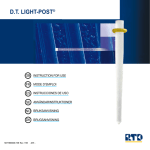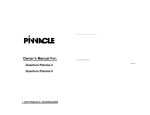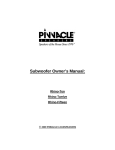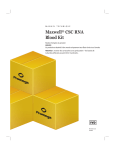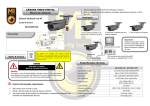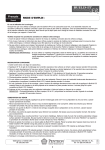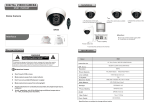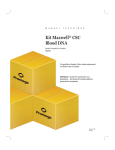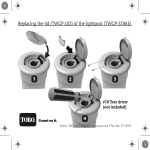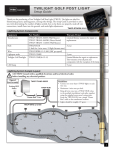Download GB INSTRUCTIONS FOR USE FR MODE D`EMPLOI
Transcript
4. GB INSTRUCTIONS FOR USE DESCRIPTION Double Taper Light-Post™ Illusion™ X-RO® is a yellow translucent fiber post with a colored resin matrix which becomes translucent in the mouth. The post color will reappear on command under cold air, water spray if re-treatment is required. The radiopacity level of the Double Taper Light-Post™ Illusion™ X-RO® is 340% Al equ. (ISO 4049) ■ 0,5 ■1 ■2 ■3 Ø apical tip 0.80 0.90 1.00 1.20 ØPost head 1.25 1.50 1.80 2.20 Double taper .02/.04 .02/.06 .02/.08 .02/.10 INDICATIONS FOR USE In case of insufficient residual tooth structure (<4 mm), the post is needed to support and secure the coronal restoration. CONTRAINDICATIONS If coronal tooth structure is less than 1.5 mm. PRECAUTIONS The post must be cleaned with alcohol before insertion in the canal. Avoid touching the posts with your fingers after cleaning. Shortening the post should be done outside of the mouth. The use of rubber dam is recommended. The crown must cover the preparation of at least 1.5 mm of healthy dentin in order to get the ferrule effect. ADVERSE REACTIONS None known to date. STEP-BY-STEP INSTRUCTIONS 1. Root canal preparation: remove gutta-percha to preplanned depth with a Gates-Glidden, Peeso reamer or Largo. Radiographic verification is recommended. 2. 3. Select the correct Double Taper Light-Post™ Illusion™ X-RO® size. Determine the post size according to the anatomical situation of the tooth using the radiograph and the plastic calibrating card. Determine the length of the coronal build-up, which will account for 1/3 of the final post length. Remove the root filling with the Double Taper Universal Drill (rotation speed 1000-2000 rpm) as deep as necessary for the post to be inserted to 2/3 of the root length. At least 4 mm of root canal filling should remain in the apical region. In case of curved canal, this calculated length is not suitable. NOT1590CA00-110628.indd 1-5 Shape the canal with the Double Taper finishing Drill corresponding to the selected Double Taper LightPost™ Illusion™ X-RO® post size, (rotation speed 10002000 rpm). 5. Try in the post, to check that the post is properly seated in the canal 6. Shorten the post to its final length with a diamond disc outside of the mouth. Never use a crimping instrument, such as wire cutters, as the pressure can destroy the structure of the post. 7. Clean the post with alcohol. 8. Apply etchant in the post space and to the exposed dentin for 15 seconds*. Rinse for 10 seconds. Remove the excess water with paper points but leave surface moist. Do not put the etchant in contact with the gingiva. 9. Apply 2 coats* of the primer with a thin brush (e.g. Composibrush RTD) in the post space. Remove excess using paper points and gently air dry all surfaces. Enamel and dentin surfaces should have a uniform, glossy appearance. If not, repeat application. Light-cure the primer* inside the post space for 10 to 20 seconds. 10. Apply a single coat of primer to the post. Gently air dry 5 seconds and light-cure the post for 10 to 20 seconds (if needed) outside the mouth*. 11a. If using a dual cure resin cement for both cementation and core build up such as Corecem™ (recommended technique): Mix the cement and apply it in the post space from bottom to the top using the root canal tips. Seat the post immediately. Light-cure for 40 to 60 seconds. Continue applying the core build up using a plastic Coreform™ matrix, or directly on the tooth. 11b. If using separate cement and a core build up resins : Mix the cement* and apply it to the post and then in the post space using a Lentulo spiral or a syringe tip. Seat the post immediately. Remove excess cement with appropriate instruments. If using dual-cure cement, light-cure for 40 to 60 seconds, applying gentle pressure on the post with the tip of the curing light probe. Apply 2 coats of bonding agent* to the exposed post(s), cement and involved tooth structure. Remove excess and air-dry with jet of air. Light-cure for 20 seconds (if needed). 11c. If using a self etching cement*, there is no need to etch and prime the post space. Mix the cement and apply it in the post space from bottom to the top using a root canal tip. Seat the post immediately. Remove excess cement. Light cure if needed. After etching, rinsing, drying, apply 2 coats of bonding agent* to the exposed post(s), cement and involved tooth structure. Remove excess and air dry with jet of air. Light cure for 20 seconds (if needed). 12. Directly model the build-up using a composite core build-up material*. R.T.D. recommends that the coronal end of the post be covered by core composite. In cases where a prosthetic crown is not indicated, a minimum of 1 mm of composite restorative should cover the post and that should be an appropriately-shaded, polishable, aesthetic composite. If the Illusion post cannot be adequately covered with composite, then a non-Illusion version can be utilized. 5. OTHER RECOMMENDATIONS FR A thick rubber dam can momentarily prevent the post to change color. Double Taper Light-Post™ Illusion™ X-RO® are single use devices. They must not be re-used to avoid the risk of contamination. MODE D’EMPLOI Double Taper Light-Post™ Illusion™ X-RO® can be cleaned DESCRIPTION with alcohol. They can neither be sterilised nor disinfected in thermodisinfector. The use of autoclave is not recommended. A re-access carbide kit is available if needed. Contact your RTD distributor. Double Taper Universal Drill and Double Taper Finishing Drill: these instruments are supplied non-sterile. Disinfect and sterilize instruments before each use. Disinfect instruments with disinfecting or cleaning agents adapted for rotary instruments*. Do not disinfect instruments in thermodisinfector. Inspect instruments visually before each use: change to new drills when they are damaged, corroded or dull. The Starter drill may be used only to remove root canal filling partially, and the finishing drills may be used only to prepare root canal. Starter Drill and Finishing drills must be sterilized individually in an autoclave with the following settings**: • Wrap individually in disposable sterilization pouches or tubing that comply with the regulation standard in force in the country of use (e.g EN ISO 11607-1), • Autoclave: type B complying with regulation standard in force (e.g EN 13060), • Sterilization temperature: 134°C - sterilization time: 18 minutes. Use a new drill after 12 -15 uses. For profoundly flared or ovoid canals, the use of accessory post, such as Fibercone™, is indicated for best results. STORAGE Store the sterilized components in a dry, dust-free place. If the packaging’s integrity appears to be compromised, before using again, place the component in a new pouch ad re-sterilize according to the protocol defined before. Do not store the post in direct sun light or artificial light. SAFETY AND LIABILITY RTD declines any liability or compensation for possible damage due to: - use of instruments which do not belong to the system and which may impair the function, - failure to observe the instructions for use. The user is responsible for testing the material for its suitability and use for any purpose not explicitly stated in the instructions for use. Selection of the correct drill and post is the responsibility of the user. For dental use only. Double Taper Light-Post™ Illusion™ X-RO® est un tenon jaune translucide coloré dans la masse. Il devient jaune translucide en bouche. Sous simple spray d’eau froide le tenon redeviendra coloré en cas de besoin de visualisation. Son niveau de radio-opacité est de 340% Al equ. (ISO 4049) RTD 3 rue Louis Neel 38120 St Egrève France www.rtd.fr [email protected] ■1 ■2 ■3 0.80 0.90 1.00 1.20 Ø tête 1.25 1.50 1.80 2.20 .02/.04 .02/.06 .02/.08 .02/.10 Double conicité INDICATIONS Le tenon sert de support à la restauration coronaire en cas de substance dentaire résiduelle inférieure à 4 mm. CONTRE-INDICATIONS Parois dentinaires inférieures à 1.5 mm au niveau coronaire. PRECAUTIONS D’EMPLOI Le tenon doit être nettoyé à l’alcool avant toute insertion dans la bouche du patient. Ne pas toucher le tenon avec vos mains. Le tenon doit être coupé à l’extérieur de la bouche du patient. L’usage de la digue est recommandé. Le recouvrement prothétique doit être d’au moins 1.5 mm de structure dentaire saine pour obtenir l’effet de sertissage désiré (Ferrule effect). EFFETS SECONDAIRES Aucun effet secondaire connu à ce jour. PREPARATION PAS-A-PAS 1. Préparation canalaire : retirer la gutta-percha à la profondeur prévue avec un foret Gates-Glidden, alésoir Peeso ou Largo. Une vérification radiographique est recommandée. 2. 3. * Refer to the manufacturer’s instructions for use. ** Please refer to your autoclave manufacturer for specific sterilization instructions if needed Manufacturer : ■ 0,5 Ø pointe 4. Choisir le tenon Double Taper Light-Post™ Illusion™ X-RO® adapté à l’anatomie du canal d’après analyse radiographique et film calibreur. Déterminer la hauteur du faux-moignon : elle devra être 1/3 de la longueur totale du tenon. Retirer l’obturation canalaire aussi profondément que nécessaire avec le foret Double Taper Universal Drill (1000-2000 t.min-1), afin de permettre au tenon d’être inséré sur 2/3 de la longueur radiculaire. Il doit rester un minimum de 4 mm d’obturation jusqu’à l’apex. Dans le cas de canaux très courbés, il n’est pas toujours possible d’atteindre cette longueur. Préparer le canal radiculaire adapté au tenon choisi avec le foret Double Taper Finishing Drill correspondant (1000-2000 t.min-1). Vérifier que le tenon est bien ajusté au canal ainsi préparé. 6. Raccourcir le tenon à la longueur adéquate avec un disque diamanté. Ne pas utiliser de pinces, car la pression exercée risque de détruire la structure du tenon. 7. Nettoyer le tenon à l’alcool. 8. Mordancer le canal et la partie coronaire pendant 15 secondes*. Rincer le canal pendant 10 secondes et le sécher légèrement avec des pointes de papier. Les parois canalaires doivent rester humides. Eviter tout contact avec la gencive. 9. Appliquer 2 couches d’adhésif* sur la préparation à l’aide de l’applicateur de type Composibrush RTD. Retirer l’excès de produit avec des pointes de papier. Sécher légèrement avec un jet d’air. La surface canalaire doit avoir un aspect lisse et brillant. Si tel n’est pas le cas, renouveler l’application. Photo-polymériser l’adhésif* dans le canal pendant 10 à 20 secondes. 10. Appliquer une seule couche d’adhésif* sur le tenon. Sécher 5 secondes avec un jet d’air. Photo-polymériser pendant 10 à 20 secondes (extra oral) si nécessaire. 11a. Cas d’une utilisation avec le même produit comme ciment et composite de reconstitution tel que le Corecem™ (technique recommandée). Mélanger le ciment-composite et remplir le canal de bas en haut à l’aide de l’embout « root canal tip ». Insérer le tenon immédiatement. Photo-polymériser pendant 40-60 s. Continuer la préparation du faux-moignon soit en appliquant directement soit en remplissant une matrice plastique Coreform™. 11b. Cas d’une utilisation avec deux produits séparés : un ciment et un composite pour faux-moignon. Mélanger le ciment* et remplir le canal à l’aide d’un Lentulo ou d’une seringue à injecter. Insérer le tenon immédiatement. Enlever l’excès du ciment à l’aide d’instruments appropriés. Photo-polymériser pendant 40-60 s dans le cas d’un ciment dual en maintenant l’embout de la lampe contre le tenon. Appliquer deux couches d’adhésif* sur la partie émergente du tenon et les parois coronaires. Enlever l’excès à l’aide d’un léger jet d’air. Photo-polymériser pendant 20 s à nouveau si nécessaire. 11c. Cas d’utilisation d’un ciment auto-mordançant*. Il n’est pas utile d’appliquer un mordançage et un adhésif dans le canal. Mélanger le ciment et remplir le canal de bas en haut à l’aide de l’embout « root canal tip ». Insérer le tenon immédiatement. Enlever les excès de ciment. Photo-polymériser si nécessaire. Après mordançage, rinçage et séchage, appliquer 2 couches d’adhésif* sur la partie émergente du tenon et les parois coronaires. Enlever l’excès à l’aide d’un léger jet d’air. Photopolymériser si nécessaire. 12. Reconstituer le moignon avec un matériau composite*. RTD recommande que la partie coronaire du tenon soit recouverte par le composite . Au cas où l’emploi d’une couronne ne soit pas nécessaire, un minimum de 1 mm de composite doit recouvrir le tenon. Il doit être dans ce cas d’une teinte appropriée, polissable et esthétique. Si le tenon Illusion ne peut être recouvert par un composite, alors un tenon non Illusion devra être utilisé (en cas d’absence de couronne). 12/07/11 13:51 AUTRES RECOMMANDATIONS Une digue épaisse et complète peut momentanément empêcher le changement de couleur. Les tenons Double Taper Light-Post™ Illusion™ X-RO® sont des dispositifs à usage unique. Ils ne doivent pas être réutilisés pour éviter tout risque de contamination. Les tenons ne peuvent être ni stérilisés, ni purifiés au désinfecteur thermique. Ils peuvent être nettoyés préalablement à l’alcool. L'utilisation de l'autoclave n'est pas recommandée. Un kit de réaccès canalaire est disponible en cas de besoin. Contacter votre distributeur. Forets Double Taper Universal Drill et Double Taper Finishing Drill : les instruments sont livrés non stériles. Stériliser avant chaque utilisation. Désinfecter les instruments avec des solutions* de rinçage adaptées aux instruments rotatifs. Ne pas désinfecter les instruments au désinfecteur thermique. Contrôler visuellement les instruments avant chaque utilisation : changer les instruments lorsqu’ils sont endommagés, corrodés ou émoussés. Le foret préformage ne devra être utilisé que pour déposer partiellement l’obturation canalaire tandis que les forets de finition ne devront être utilisés que pour préparer les canaux radiculaires. Les forets doivent être stérilisés individuellement par autoclave selon les paramètres suivants** : • Conditionner individuellement dans les sachets ou gaines de stérilisation à usage unique conforme à la réglementation nationale du pays (exemple EN ISO 11607-1), • Autoclave: type B conforme à la réglementation en vigueur (exemple EN 13060), • Température stérilisation : 134°C - Temps de stérilisation : 18 minutes. Changer de foret après 12 à 15 utilisations. Pour des canaux très aplatis ou ovoïdes, l'utilisation des tenons accessoires tels que le Fibercone™ est recommandée pour un meilleur résultat. u SUGGESTED POST (GUIDELINES ONLY) Fabricant : RTD 3 rue Louis Neel 38120 St Egrève France France www.rtd.fr [email protected] SIZE FOR EACH TOOTH Double Taper LIGHT-POST™ X-RO® ILLUSION™ u SUGGESTION POUR LE CHOIX DU TENON Tr a n s l u c e n t q u a r t z f i b e r GB F INSTRUCTION FOR USE MODE D’EMPLOI Stockage Conserver les produits stérilisés dans un endroit sec, à l’abri de la poussière. Avant réutilisation, en cas de non conformité de l’intégrité de l’emballage, re-conditionner et re-stériliser selon le protocole défini. Conserver les tenons à l'abri de la lumière. * Se reporter aux instructions du fabricant. ** Se reporter aux consignes spécifiques de stérilisation fournies par le fabricant. NOT1590CA00-110628.indd 6-10 | 0459 -2009- NOT1590CA00-1106 Rev.: 1106 RTD décline toute responsabilité pour des dommages causés par : - l’utilisation d’instruments étrangers au système, - le non respect des instructions d’utilisations spécifiées dans cette notice. Il revient à l’utilisateur de s’assurer que les produits sont bien appropriés à l’utilisation prévue. L’utilisateur est seul responsable du choix de la taille appropriée pour le foret et le tenon. Destiné à l’usage dentaire uniquement. - 2011 - SECURITE ET RESPONSABILITE 12/07/11 13:52



